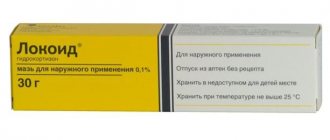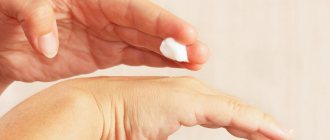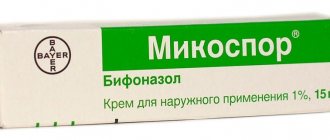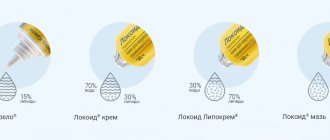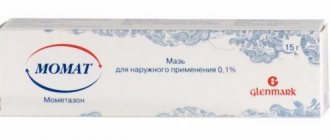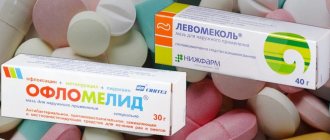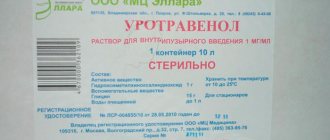Pharmacodynamics and pharmacokinetics
Pharmacodynamics
Antimicrobial agent for external use, sulfanilamide . When applied to a burn surface, silver sulfadiazine begins to disintegrate, slowly releasing sulfonamide and silver , which inhibits the growth and reproduction of infectious cells.
Dermazin has a wide spectrum of antibacterial activity, including all types of microorganisms that cause infection of wounds, including burn wounds (Escherichia coli, Pseudomonas aeruginosa, the genus Staphylococcus, Proteus, Klebsiella, Streptococcus, Enterobacter), as well as yeast fungi (Candida albicans), and a number herpevirus strains.
Able to penetrate exudate and necrotic tissue.
Pharmacokinetics
During long-term treatment of burn wounds over a large surface, the drug is absorbed into the bloodstream. Serum sulfonamide concentrations
sulfadiazine entering the blood is excreted unchanged in the urine; the half-life is 10 hours.
Instructions for Dermazin cream
The instructions, in the form of a leaflet with detailed information about the indicated treatment with Dermazin cream, are located in the packaging box with the drug. On which a brief description of the drug is duplicated.
Form, composition, packaging
The drug Dermazin is an external drug and is a white mass of uniform consistency.
The active ingredient is silver sulfadiazine + auxiliary components, which are some quantities of cetyl alcohol, propyl parahydroxybenzoate, hydrogenated peanut oil, methyl parahydroxybenzoate, propylene glycol, 60 polysorbate and purified water.
Dermazin cream is sold in cardboard packs with an aluminum tube (50g) inside. Another packaging option is a 250 gram polypropylene jar.
Storage period and conditions
The condition for storing the drug is only a temperature regime not exceeding 25 degrees. The ointment can be stored under such conditions for up to three years. Keep the storage area away from children.
Pharmacology
An external drug from the group of sulfonamides with a pronounced antimicrobial effect.
Thanks to the action of the active component, the drug helps to suppress the reproduction and growth of pathogenic bacteria in the wound surface area.
The spectrum of antimicrobial activity of the drug is quite wide. Its range can include almost every type of microbe that infects wound and burn surfaces of the skin. In addition, the drug can cope with yeast fungi and some strains of the herpetic virus.
Pharmacokinetics
The active component of the external drug has the ability to penetrate tissues that are susceptible to necrosis and exudative compartments.
No other data on the pharmacokinetics of the drug have been identified.
Side effects
- Local reactions: burning , itching .
- Hematopoietic reactions: temporary leukopenia and neutropenia.
- There are rare reports of erythema multiforme, skin necrosis, pigmentation changes and interstitial nephritis.
- In even more rare cases, sulfonamide adverse reactions are detected: agranulocytosis, aplastic anemia, leukopenia, thrombocytopenia, hepatocellular necrosis, hemolytic anemia, exfoliative dermatitis, hepatitis, dyspepsia, neurological reactions, toxic nephrosis.
Briefly about dermatitis
Dermatitis is a disease that affects the skin as a result of delayed and immediate allergic reactions.
Irritants can be any chemicals, medications, cosmetics, food agents, pollen and plant particles, etc. Dermatitis is manifested by itchy rashes of vesicles, crusts and scales on an erythematous background. There are several stages in its course:
- acute (vesicular) – develops in the first days and is characterized by the appearance of blisters on reddened skin;
- subacute (cortical) - a few days after contact with the irritant, the vesicles open, and their contents flow out and dry out with the formation of crusts and scales;
- chronic - develops with frequent contact with irritants, manifested by the appearance of areas of hyperkeratosis, lichenification, etc. on the skin.
For all types of dermatitis, rashes are characterized by itching and burning, swelling, a local increase in temperature in the affected area, and the appearance of blisters and crusts. After the process resolves, the skin remains either unchanged or with areas of hypo- or hyperpigmentation.
Instructions for use (Method and dosage)
The instructions for the ointment allow it to be used with or without bandages. This product is intended for use on the skin only.
Cream Dermazin, instructions for use
After surgical treatment of the burn, the cream is applied in a layer up to 4 mm thick once or twice a day.
Treatment is continued until the burn or wound is completely healed. The method of application is the same for the treatment of trophic ulcers and burns. Bandages must be changed daily.
Interaction
Treatment with Dermazin cream requires knowledge of combinations of the drug with other medications.
- When using the cream simultaneously with medications that promote enzymatic sanitation of the wound, it neutralizes the effect of the natural remedy.
- Combined use with histamine receptor blockers leads to a decrease in the level of leukocytes in the blood.
- It should be borne in mind that long-term therapy with Dermazin cream over large areas of the skin can provoke the opposite effect and aggravate the course of the disease.
special instructions
It is recommended to prescribe the drug with caution to persons with hypersensitivity to sulfonamides (possible cross-reactions), glucose-6-phosphate dehydrogenase deficiency (possible hemolysis ), impaired liver and kidney function (possible accumulation of the drug), and porphyria .
With long-term use of Dermazin over a large surface, blood counts should be monitored due to the possible occurrence of thrombocytopenia, leukopenia or eosinophilia.
Do not allow Dermazin to get into your eyes.
Contraindications
Like any pharmacological agent, Dermazin has contraindications for use:
- improper synthesis of red blood cells due to genetic pathology of the liver;
- intolerance to the components of the drug;
- hemolytic nonspherocytic anemia;
- wound surfaces with abundant pus;
- children born before 36 weeks of pregnancy;
- infancy;
- severely festering burn wounds;
- children up to 3 months;
- brain damage from unconjugated bilirubin;
- history of allergic reactions;
- hypersensitivity to sulfonamide drugs.
Dermazin price, where to buy
The price of Dermazin ointment 50 grams in Russia ranges from 202-223 rubles, and in Ukraine the price of this form of release is on average 118 hryvnia.
- Online pharmacies in RussiaRussia
- Online pharmacies in UkraineUkraine
- Online pharmacies in KazakhstanKazakhstan
ZdravCity
- Dermazin cream 1% 50gLek dd/Salutas Pharma GmbH
RUB 225 order
Pharmacy Dialogue
- Dermazin cream tube 50g Salutas Pharma GmbH
RUB 228 order
show more
Pharmacy24
- Dermazin 1% 50 g cream Salutas Pharma GmbH, Nimechchina
215 UAH.order
PaniPharmacy
- Dermazin cream Dermazin cream 1% 50g Slovenia, Lek
215 UAH order
show more
Features of use by different categories of patients
During pregnancy
Dermazin cream does not provide treatment for women expecting the birth of a child. The drug can be used only in exceptional cases when the health and life of a woman is seriously threatened.
It is possible that the active component penetrates into a woman’s milk, so feeding the child during treatment is prohibited. It is known about the development of hyperbilirubinemia in children when the mother breastfed the baby while taking this type of treatment.
For kidney and liver problems
For patients with these types of ill health, treatment with Dermazin is prescribed when absolutely necessary and with great caution. Possible accumulation of the active substance involves monitoring the concentration of sulfadiazine in the blood serum
Ointments for the most common forms of dermatitis
The most common are simple contact dermatitis and allergic dermatitis. They differ mainly in the speed of development of reactions - in the first case, the disease occurs at the moment of contact with the irritant, in the second - after some time (from several minutes to several hours and days).
Ointment for contact dermatitis
Simple contact dermatitis occurs when an irritant is exposed directly to the contact area. The damaging agent can be high or low temperature, ultraviolet rays, acids, alkalis, friction and any other unconditional damaging factors (that is, causing a reaction in absolutely all people, regardless of their individual characteristics). The reaction from such exposure most often manifests itself as burns and frostbite.
To treat simple contact dermatitis, antihistamine ointments (Fenistil), antiseptics to prevent infection, emollient and wound-healing creams and ointments (Bepanten, Panthenol) are used.
Ointment for allergic dermatitis
Allergic dermatitis develops some time after contact with an irritant, which can be any substance.
In this case, sensitivity to a particular agent is due to a person’s individual predisposition to allergic reactions. There are several variants of this disease. The main ones are urticaria and atopic dermatitis.
Urticaria is characterized by an itchy urticarial rash, the occurrence of which is most often provoked by mechanical factors. The course is usually acute.
Atopic dermatitis has a complex mechanism of disease development. It is not always possible to identify the specific allergens that cause the rash. The rash is represented by a variety of elements - papules, vesicles, spots, scales, cracks, crusts, etc.
Treatment for atopy and urticaria has similar principles. It starts with local therapy. Ointment for allergic dermatitis in adults and children is selected from among antihistamines and hormonal drugs. With their help, acute inflammation is relieved. Then, until the rashes are completely resolved, non-hormonal ointments and creams are used. It is better to use emollients constantly to maintain the protective properties of the skin and protect it from dryness and dehydration.
Ointment for dermatitis on the skin in adults and children is one of the links in local treatment. The doctor must decide which external agent from which group is most suitable, taking into account the clinical characteristics of the disease. In most cases, local therapy is sufficient to relieve symptoms. If the disease cannot be controlled, systemic agents are additionally prescribed.
Release form and composition of the ointment
One of the dosage forms of Dermazol is a cream of two percent concentration, used externally. It is packaged in aluminum tubes with a volume of fifteen or thirty grams. There is one tube in a cardboard package. The main active ingredient is ketoconazole, contained in the amount of twenty milligrams per gram of ointment. The excipients are as follows:
- propylene glycol;
- purified water;
- disodium edetate;
- cetostaryl alcohol;
- polysorbate-80;
- cetomacrogol 100;
- paraffin in two varieties - soft white and liquid light.
According to the instructions, Dermazol ointment is white in color, has a uniform and viscous structure without lumps. There is no pungent odor and does not leave marks on clothes.
Analogs
The pharmaceutical industry produces drugs that have similar properties. Unlike Dermazin ointment, analogues may differ in chemical composition and scope of application:
- Argedine is a dosage form in the form of a cream, containing silver sulfadiazine in an amount of 10 mg. Approved for use in children from two years of age.
- Sulfargin is an ointment with a similar active ingredient. The drug is packaged in 180 and 500 ml.
- Argen - the main component is represented by an aerosol, which can be used by adults and children from 1 year.
- Streptocide ointment - contains sulfonamide, which has an antimicrobial effect against a wide range of microorganisms. The drug is not recommended for children and pregnant women.
Briefly about the drug
Dermazin cream contains silver sulfadiazine as the main active ingredient. This drug in the human body breaks down into sulfanilamide and silver ions.
Sulfanilamide is a broad-spectrum antibiotic. It inhibits the activity of bacteria, preventing their reproduction, growth and vital activity.
Silver ions also have an antimicrobial effect, destroying the cell wall of microorganisms. Due to this, silver potentiates the antibacterial effect of sulfonamide. This allows the use of lower concentrations of the antibiotic in the drug without loss of its effectiveness. As a result, toxic reactions to Dermazin develop extremely rarely.
Additional components of the ointment (alcohol, peanut butter, polysorbate, propylene glycol, etc.) do not have a special effect on the effect of the drug.
Dermazin cream contains silver sulfadiazine in a concentration of 1%.
The drug is produced in aluminum tubes of 50 grams and plastic jars of 250 grams. The shelf life of this medicine is three years if stored in a cool, dark place, protected from direct sunlight.
What effects does Dermazin have?
The effect of Dermazin cream is not limited to antibacterial activity. Additionally he:
- reduces pain and discomfort;
- stops inflammatory processes;
- eliminates redness;
- promotes faster healing of the skin, activating its regenerative abilities, restoring and renewing cells.
This drug is characterized not only by its high efficiency, but also by its safety in use.
